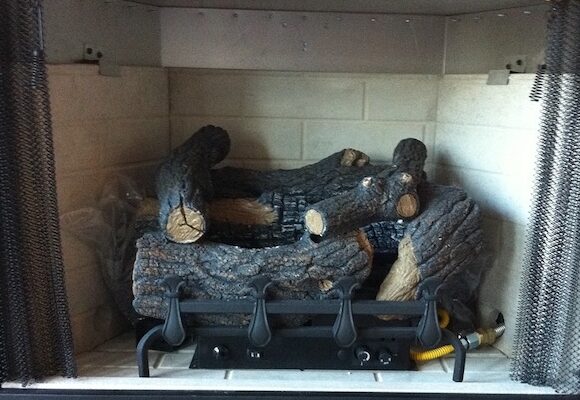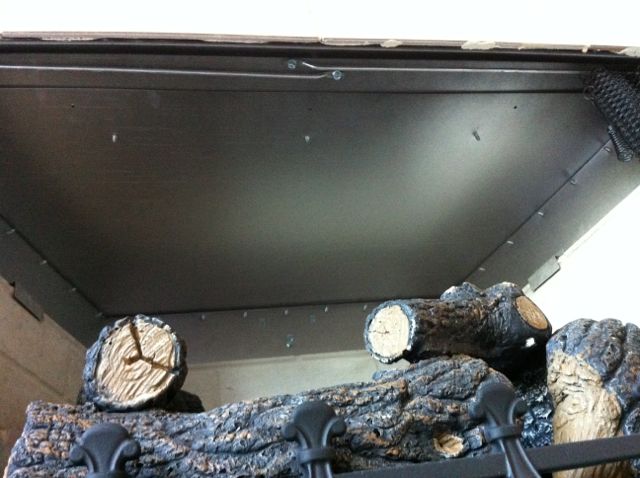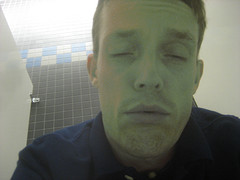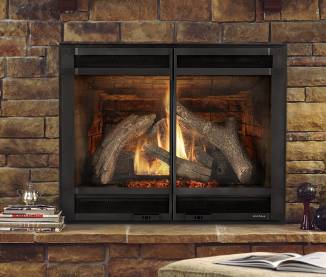A Ventless Gas Fireplace Is a Liability

First of all, let’s call it what it really is. The industry likes the term “vent-free” when talking about gas fireplaces that keep all the exhaust gases in your home. I prefer the term “ventless” or, even better, “unvented.” Not a huge deal, but the ventless gas industry wants you to feel that you’re being liberated of a burden by not having an exhaust vent. I think it’s important for people to know that they’re actually missing something important when they go with a ventless gas appliance.
Second, unvented gas fireplaces are a liability. I wouldn’t have one in my house and advise those who do have one either to remove it, replace it, or just not use it. Yes, I know that some people love them and have never had a problem with theirs. Those people have commented in some of my articles criticizing these appliances. I also know, however, that plenty of people with unvented gas fireplaces complain of headaches and other problems.
Before we get into the fun stuff, let me address the question of how to determine if your gas fireplace is vented or not, just in case. The answer is quite simple. You put your head into the fireplace (remember to turn it off first!) and look up. If there’s a hole, it’s vented. In the photo below, all I saw was a steel plate with no hole.

An article that just won’t quit
I’ve written about combustion safety here in the Energy Vanguard Blog a number of times and will continue to do so because it’s such an important part of building science and home performance. The most popular article of all over the past 6 months has been Bob Vila and the Vent-Free Gas Fireplace — A Sorry State of Affairs, which I wrote over a year ago. Lately it’s been getting 200-300 views every day.
Why is this article so popular? I think it’s because a lot of people are looking to understand the issues. More than a few are feeling ill when they use unvented fireplaces, and they want to confirm their suspicions. These things are in a lot of houses now, and people are buying those homes without knowing of the problems.
people are buying those homes without knowing of the problems.
Occasionally, people insist on getting the unvented gas fireplace. Todd Vendituoli, a contractor/blogger in Vermont/Bahamas, commented in the Bob Vila article that he lost a job because the client wouldn’t hear of a vented model. Years later, Todd ran into them and they told him “that the fireplace was a mistake and had taken it out.”
You can read the full article by clicking the link above, but let me repeat the main reasons that ventless gas fireplaces are bad:
- Even when working perfectly, they put a lot of water vapor into the house. (See my article on how combustion of natural gas works.)
- Drafts, fans, candles, and tight houses can mess up the combustion process.
- Many homeowners don’t understand how to operate or maintain them.
If you read the articles I linked to and the comments, you’ll see that there’s a very good reason that you won’t find people who understand building science recommending these things.
Meet Perry Bumpers
Yesterday I got an email from Perry Bumpers. His company, Fireplace Creations by BMC, sells gas fireplaces in Tennessee, and I linked to his website in my Bob Vila article. I didn’t know him then and have never communicated with him until he wrote to me yesterday. I linked to his site because he refuses to sell unvented gas fireplaces and proclaims so publicly on his website.
He reached out to me to tell me that every year in the heating season, they get a lot of complaints from people who have ventless gas fireplaces in their homes. They want to find out if it’s really true that these appliances could be the cause of their health problems and what they can do about it. At the time he wrote, he said he had a man in his showroom whose wife sent him there to “get the correct information about their ventfree logs they have in there home. She had told him go to BMC and get the facts, that she was not crazy that the logs were making her head hurt and making her sick.”
 Bumpers wrote that they’ve done about 40 estimates to replace ventless gas fireplaces with direct-vent models so far this season and replaced about 10. The others would like to do it, he told me, but they don’t have the money for it yet. The main reasons their customers give for wanting to replace the ventless models are “complaints about bad smell, soot, moisture and health related issues.” Because of all that he knows about unvented gas fireplaces and the complaints he hears from people who use them, he wrote, “It’s mind boggling to me vent-free products are still being sold.”
Bumpers wrote that they’ve done about 40 estimates to replace ventless gas fireplaces with direct-vent models so far this season and replaced about 10. The others would like to do it, he told me, but they don’t have the money for it yet. The main reasons their customers give for wanting to replace the ventless models are “complaints about bad smell, soot, moisture and health related issues.” Because of all that he knows about unvented gas fireplaces and the complaints he hears from people who use them, he wrote, “It’s mind boggling to me vent-free products are still being sold.”
It’s nice to see companies choose to do the right thing, as Vendituoli and Bumpers do, even if it means losing some business. As Bumpers wrote to me, “We will never stop trying to make sure the consumer has the facts about vent-free products.”
I know it’s unlikely that these things will go away anytime soon, but the more people find out about these problems, the better. As homeowners doing their research find out the truth and turn away from these ventless gas fireplaces, homes become safer.
Related Articles
Bob Vila and the Vent-Free Gas Fireplace — A Sorry State of Affairs
3 Problems with Atmospheric Combustion Inside the Building Envelope
Unvented Natural Gas Space Heaters Should Be Removed
Fire! — Understanding What’s Happening in Your Combustion Appliances
Photo of sick person by akeg from flickr.com, used under a Creative Commons license.
This Post Has 25 Comments
Comments are closed.

From the very beginning of
From the very beginning of the ASHRAE 62.2 Committee, in early drafts we outlawed house vented fireplaces (so called vent free). The gas industry reacted with a vengence and was able to get the standard changed to say nothing about these appliances that put moisture, carbon dioxide and on occasion NOX and CO into homes. Breathing combustion products is bad for you even if you don’t feel sick. Just because occupants don’t complain, they can be affected. Just like the gas industry blocked CO monitors from 62.2, they did the same thing by making the Standard not address these devices.
For a fossil fuel natural gas is great. It usually burns cleanly with little problem. However the results should always be vented.
It is unfortunate how common
It is unfortunate how common it is to lose jobs because you refuse to do things that you know are wrong. Most of the time when I meet potential clients they already have an idea of what they “need.” So when I go in with actual solutions they don’t want to hear it. The scary thing is safety issues are the most common issues to be ignored.
I have yet to find a new home
I have yet to find a new home builder installing an unvented appliance.
I find them in existing homes. I always look for the vent on the outside also I found one vented unit that was vented into the interior wall cavity.
Remember to look at both ends.
John P.:
John P.: Thanks for your comments. Because many readers here may not realize that you’re one of the top HVAC experts in the country, I’ll provide this link to your website, where they can learn a bit about your credentials:
About Proctor Engineering
Chuck R.: Yes, that’s true, but I think it’s changing, bit by bit. We all just have to keep speaking the truth. Those who want it will find it.
John N.: Well, Kansas must be doing better than Georgia then. The two photos at the top are of a ventless gas fireplace in a brand new home in Savannah.
It’s funny how a HHVAC
It’s funny how a HHVAC contractor will condemn a furnace for the smallest crack in a heat exchanger, yet these ventless fireplaces are still being installed? How is a ventless fireplace different than a furnace where the exhaust is ran straight into the living space?
Well done again Allison.&
Well done again Allison.
In future blogs you might also include “The Vented Fireplace In A Negative Pressure Room” … a close cousin of the unvented fireplace.
Let’s call them what they are
Let’s call them what they are – Lung Vented.
We have always refused to
We have always refused to work on project that feature these units.
Several years ago I sat across the table from a builder attempting to win the largest project we had ever had (1500 Energy Star homes). I explained that burning fuel in the house with no vent, whether deadly, or very dangerous, or not dangerous, certainly worked against our goals of building healthy houses. He would have to take them off the table to work with us. I held my breath & he agreed. Of course they built about a dozen houses before going bankrupt (the big crash) – oh well.
I always use that argument as well as pointing out that they’re illegal in something like 16 states & Canada. There must be a reason. That usually gets peoples attention.
I wonder about this. If
I wonder about this. If ventless gas exhausts lots of water vapor, why is not this good for a dry house in the winter? A humidifier does the same thing.
I grew up in the west where we had no heat at all except open gas burners, one in every room. The house was very leaky, but the flames burned blue and not one of the five of us can remember any bad effects.
What about the other point, i
What about the other point, i.e. a blue flame burns completely, i.e. no CO. It is easy to tell whether it is clean by its color. I have tried to tighten insulation around my 1940 brick rambler, but it will never be a modern house. This seems an acceptable tradeoff to me. An efficient heat source with low contaminants and useful humidity in return for a little higher gas bill than in a modern house.
Robert — A leaky house in a
Robert — A leaky house in a dry climate may not have moisture problems given the drying on the warm days. A tight house the moisture added alone can be a problem. The larger problem is the health effects of the other pollutants that may not cause you to feel sick, but have an effect on your health.
Otherwise I am reminded of my mother-in-law’s position that she doesn’t need a seat belt because she is still alive without having used one all her life.
All good points. Thanks. Do
All good points. Thanks. Do you have an article on a gas fireplace that could be installed in an older brick chimney which would be efficient? It is discouraging to pay for heat only to have it mostly go up the vent.
Also, is it possible to rent an infra-red gun? The closest trained energy auditor is 50 miles away, so I may have to do this myself. The door blower seems easy enough, but my real problem is lack of insulation in the ceiling which would require the gun.
Thinking more about this, how
Thinking more about this, how does the CO given off by ventless gas fp compare with the air we who live in major cities breath every day by cars? If even small quantities can harm health, we must all have some damage from air we all breathe every day as opposed to the dozen or so days in the winter when a ventless fp is working.
Doesn’t it make sense, then,
Doesn’t it make sense, then, that every gas kitchen range should have a range hood that vents to the outside (and that is turned on every time the stove is used). Ranges are used a lot more often that gas fireplaces, I suspect.
Your customary excellent
Your customary excellent reporting, Allison.
On a related item, vented gas fireplaces, here’s an article I posted in ’10 about a Canadian study concerning use of gas fireplaces for zone heating. For reasons that escape me, Canadians have an obsession with understanding the science of home heating :–).
http://homeenergypros.lbl.gov/forum/topics/canadian-study-of-gas
Best wishes
I’m sure if the manufacturers
I’m sure if the manufacturers haven’t been sued into oblivion yet that apparently these things aren’t quite as unsafe as they seem, but based on my intuition anything ventless that burns enough of anything containing carbon to considerably heat up a room seems like CO poisoning waiting to happen. I know that natural gas is among the cleanest burning of fossil fuels, but that’s only true under optimal conditions: well designed, clean nozzles, etc. In practice, there’s know-it-all contractors going beyond their core competency, there’s homeowners who try to burn wood in these things and think of the gas supply as an easy way to get the wood to light on fire… I live in Northern California where many small houses and definitely apartments do not have central heat but instead small gas heaters, and as far as I’ve seen, even the smaller ones of those are always vented. So are gas water heaters. The biggest unvented gas burning appliance I’ve seen is an oven. If I bought a house with one of these, I’d want some pretty hard evidence that they were harmless, and some pretty solid CO detectors, before operating it.
Allison, if i post a fact
Allison, if i post a fact/experience-argument that refutes this campaign against these devices, will you close this blog too claiming that commenters with vested or commercial interests that do not align with yours have invaded the blog?
I have a quality ventless gas stove in my fireplace. Nearby are MSA CO sensors and one aircraft-grade 1ppm sensor that have never registered anything but zero. Yes, following certified calibration. Nothing like having good ole data.
Oh, I do not sell any of this stuff, including the services you-all do. I’m just one of those stupid consumers.
Bob: "
Bob: “Lung-vented” is a good term for them!
Don G.: Yeah, a vented pressure in a room with negative pressure is also room-vented.
Skye D.: Kudos to you. It’s hard to refuse work, but I’d rather stand on principle and go broke than do things that I know are unsafe.
Robert T.: It looks like Skye And John Proctor addressed most of your questions. Renting a thermal imaging camera may be possible, but unless you’ve had training, it may not be helpful to you, and it could even give you misleading results.
John P.: I like the seatbelt story. I’ll be using that one.
Nate A.: You’re welcome, Nate. Please do write about it. We need to keep getting the word out.
Don W.: Yes, gas ranges–and even worse, gas ovens–need to have range hoods that are vented to the outside and used whenever the appliance is used. Here are a couple of articles related to that:
Don’t Let the Turkey Get You Down! Carbon Monoxide alert
Recirculating Range Hoods — As Effective As Recirculating Toilets
Steve W.: Well, I sure hope Canadians are obsessed with heating, at least next week when I’ll be in Toronto!
Jaap W.: Sounds like you have a good grasp of the potential problems.
John: I’m still waiting for an “argument that refutes this campaign against these devices.” You flatter yourself if you think you can say something that will cause me to close comments here. I just get tired of responding to people who make themselves look like idiots who haven’t even read what I wrote. Now, what was that you were saying about providing some kind of evidence?
I see no empirical data in
I see no empirical data in this article, only anecdotal evidence. The story about the man with the head achy wife is a perfect example and reminds me of clients who call me crying that their computer crashed after installing a completely unrelated update.
If you are serious about steering people away from unvented fireplaces and heaters (and I assume you are), you have to lay off the unverifiable scare tactics and reliance on post hoc ergo propter hoc and start presenting hard data to support your claims. How about a study of a few dozen (or preferably hundreds) of various makes and models of unvented appliances (blue flame, radiant, fireplace), noting the BTU’s of the unit, cubic feet and R-value of the room and the CO and CO2 measurements in fifteen minute increments over a period of, say, eight hours? Believe it or not such studies actually matter and anything less is just talk, regardless of the amount of education and experience the person doing the talking might have.
PS: I’ll give you point regarding moisture because everyone knows that water vapor is a byproduct of fossil fuel combustion. However, that really is the least important issue since the advent of a nifty little appliance called the dehumidifier.
We recently turned ours on
We recently turned ours on and immediately realized the issues you point out. Who do we contact to replace in the Austin/central Texas area.
Use those data loggers to see
Use those data loggers to see the effect on humidity. Lady you dont want to have to run a dehumidifier. lOL
We recently bought a house
We recently bought a house with a ventless gas fireplace. Since realising it’s ventless I’ve been wondering what to do with it. Any ideas? Can you retrofit venting?
@Bradley
@Bradley
As best I know they are not convertible to venting. If your home had a real fireplace with c chimney, you can put in a vented gas fireplace.
Hi, I have a “unvented
Hi, I have a “unvented” fireplace. My question is if I take the logs out, is it safe to use for about 4-6 hours at a time? There is no smell with the logs taken out. Thank You
Gas appliances vented into
Gas appliances vented into the occupied space are always a potential problem. Even if they don’t “smell” they are still a problem. CO is an odorless, tasteless gas. These devices also produce NOx which is also a health hazard. If you can find the manufacturer’s instructions for the house vented fireplace, you will probably find that they say you should open a window when you run the device and that it is “decorative” only. 4 to 6 hours is way, way, way too long.